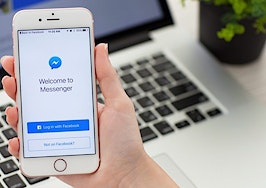- Because 90 percent of Facebook’s daily active users are mobile, real estate agents need a lead generation strategy that’s mobile-friendly. Facebook Lead Ads are the answer.
If you’re like most real estate agents who run Facebook ads, you’re probably linking each ad to a page on your website. If you’re really serious about your marketing, you might even be using landing pages to capture their contact info.
Landing pages are great at capturing leads’ contact info if they’re browsing Facebook on a desktop or laptop, but what if they’re using the Facebook or Instagram app on their phone?
Are the same landing pages that work well on desktops and laptops an effective way to capture a lead’s contact info on a mobile device?
Short answer: No, landing pages don’t work as well on mobile devices.
And because 90 percent of Facebook’s daily active users are on their mobile devices (Instagram is probably closer to 99 percent), you need to have a lead generation strategy that’s mobile-friendly.
If you don’t, you’re leaving leads on the table.
The solution? Facebook Lead Ads
Facebook Lead Ads are a seamless way to capture leads’ contact info without redirecting them to a landing page.
More importantly, they’re better at generating leads than landing pages when people see your ads on mobile devices.
With Lead Ads, a contact form pops up right inside of the Facebook or Instagram app when someone clicks on your ad.
Facebook even automatically fills out a Lead Ad form with a lead’s full name, email and phone number when he or she clicks on your ad (that’s a game changer).
My reaction when I found out Facebook Lead Ads are auto-filled with a lead’s contact info.
Why do Facebook Lead Ads work better than landing pages on mobile devices?
There are three big reasons:
They work faster on mobile devices
Landing pages take longer to load on mobile phones than they do on desktops and laptops.
That’s bad news because 40 percent of people abandon a website that takes more than three seconds to load.
With Lead Ads, a Facebook user doesn’t even have to leave the app to submit his or her contact info.
Everything happens instantly right inside the Facebook app, which reduces the friction a lead would normally feel when asked for contact info.
They’re more trustworthy
As soon as someone clicks on an ad and leaves Facebook, they become more skeptical.
They’ve left a familiar place that they know and trust and suddenly have to determine whether they trust your website enough to submit their contact info.
With Lead Ads, the entire lead generation process happens right inside the Facebook or Instagram app, which means people will be more comfortable with submitting their contact info.
They’re automatically filled out with a lead’s contact info
This is the single most important reason Lead Ads work better on mobile devices than landing pages.
Lead Ad forms are automatically filled out with a lead’s full name, email and phone number.
That reduces the number of steps a lead needs to take and creates what marketers call “behavioral inertia,” which just means leads are more likely to submit their info because the first step has been taken for them.
The result is higher conversion rates when compared to landing pages where leads have to manually enter contact info on a website that’s foreign to them.
Here’s how Facebook Lead Ads work
To run Facebook Lead Ads, you’ll need to create your campaign inside Facebook’s Ads Manager using the “Lead Generation” campaign objective.
Once you’ve set up your campaign, create your ad with a clear call-to-action (we’ve found that carousel ads produce higher click-through-rates than single-image ads).
From there, you’ll need to create a Lead Ad form that reiterates your call-to-action and collects the contact info that you’ll need to follow up.
As a best practice, it’s a good idea to limit the number of fields in a Lead Ad form to two or three.
Requesting too much info from a lead will reduce the number of people who actually submit the form (remember: you can always get more info when you follow up).
Here’s how a Facebook Lead Ad works in real time:
- Someone clicks on your ad
- A form pops up that’s automatically filled out with his or her info
- He or she hits submit, and his or her info is sent to your email
Unfortunately, Facebook doesn’t currently have a native email integration, which means you’ll need to use something like Zapier to integrate Lead Ads with your email or CRM.
You can, however, download all of the leads you’ve captured with your ads under the “Publishing Tools” section of your Facebook page (here are some instructions).
Start using Facebook Lead Ads
Facebook has been heavily promoting its Lead Ads format recently to encourage more advertisers to take advantage of this powerful tool.
I think there’s a couple of reasons for this.
For one, Facebook would rather people stay on its platform when someone clicks on an ad than be redirected to an external website (Facebook’s ultimate goal is to keep more people on Facebook for a longer period of time).
The other reason — I speculate — is that Facebook is encouraging advertisers to use Lead Ads is to help them get better results, which means they’ll ultimately spend more on Facebook ads.
This isn’t a bad thing because it’s a win-win for both Facebook and advertisers like us.
Let me know if there is something specific you want me to cover that relates to Facebook advertising!
Nate Dadosky is the owner of Nate Dadosky Marketing in Charlotte, North Carolina. Follow him on Facebook and Twitter.




